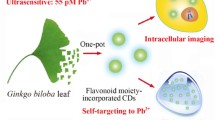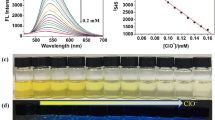Abstract
A novel nitrogen doped and surface functionalized fluorescent CDs (T1) was synthesized by one-step and green hydrothermal method, which exhibits a satisfactory fluorescence quantum yield and a series of admirable features such as good aqueous solubility, narrow particle size distribution, resistance to photobleaching as well as excitation-dependent behavior. Benefitting from above merits, T1 can be employed to serve as an outstanding sensing platform for sensitive and accurate detection of ClO– by remarkable fluorescence “on–off” process with rapid and anti-interference. More notably, the good biocompatibility and photostability can ensure enormous bioimaging potential and successful application of T1 in monitoring of exogenous ClO– in MG-63 cells. Meanwhile, T1 can also be regarded as a filter paper sensor providing a convenient and efficient analyzing technology for monitoring of free residual chlorine in practical environmental samples. All these results demonstrate that there exists promising possibility for practical applications of T1 in bioimaging systems and environmental monitoring.
Graphical abstract









Similar content being viewed by others
Data Availability
All data generated or analyzed during this study are included in this published article and its supplementary information file.
References
Chen XQ, Tian XZ, Shin I, Yoon J (2011) Fluorescent and luminescent probes for detection of reactive oxygen and nitrogen species. Chem Soc Rev 40:4783–4804. https://doi.org/10.1039/c1cs15037e
Wu LL, Sedgwick AC, Sun XL, Bull SD, He XP, James TD (2019) Reaction-based fluorescent probes for the detection and imaging of reactive oxygen, nitrogen, and sulfur species. Acc Chem Res 52:2582–2597. https://doi.org/10.1021/acs.accounts.9b00302
Zheng MH, Hu X, Wang XW, Liu XL, Jin JY (2016) Fluorescence-enhanced sensing of hypochlorous acid based on 2-pyridylthiazole unit. J Fluorec 26:593–598. https://doi.org/10.1007/s10895-015-1745-4
Li XH, Gao XH, Shi W, Ma HM (2014) Design strategies for water-soluble small molecular chromogenic and fluorogenic probes. Chem Rev 114:590–659. https://doi.org/10.1021/cr300508p
Hou JT, Zhang M, Liu Y, Ma XF, Duan R, Cao XH, Yuan FY, Liao YX, Wang S, Ren WX (2020) Fluorescent detectors for hydroxyl radical and their applications in bioimaging: a review. Coord Chem Rev 421:213457–213473. https://doi.org/10.1016/j.ccr.2020.213457
Ramsey MR, Sharpless NE (2006) ROS as a tumour suppressor. Nat Cell Biol 8:1213–1215. https://doi.org/10.1038/ncb1106-1213
Dai YJ, Ding YM, Li LL (2021) Nanozymes for regulation of reactive oxygen species and disease therapy. Chin Chem Lett 32:2715–2728. https://doi.org/10.1016/j.cclet.2021.03.036
Hammer A, Desoye G, Dohr G, Sattler W, Malle E (2001) Myeloperoxidase-dependent generation of hypochlorite-modified proteins in human placental tissues during normal pregnancy. Lab Invest 81:543–554. https://doi.org/10.1038/labinvest.3780263
Shen SL, Zhao X, Zhang XF, Liu XL, Wang H, Dai YY, Miao JY, Zhao BX (2017) A mitochondria-targeted ratiometric fluorescent probe for hypochlorite and its applications in bioimaging. J Mater Chem B 5:289–295. https://doi.org/10.1039/c6tb01992g
Prokopowicz ZM, Arce F, Biedron R, Chiang CLL, Ciszek M, Katz DR, Nowakowska M, Zapotoczny S, Marcinkiewicz J, Chain BM (2010) Hypochlorous acid: a natural adjuvant that facilitates antigen processing, cross-priming, and the induction of adaptive immunity. J Immunol 184:824–835. https://doi.org/10.4049/jimmunol.0902606
Mathon NF, Lloyd AC (2001) Cell senescence and cancer. Nat Rev Cancer 1:203–213. https://doi.org/10.1038/35106045
Kalyanaraman B (2021) Reactive oxygen species, proinflammatory and immunosuppressive mediators induces in COVID-19: overlapping biology with cancer. RSC Chem Biol 2:1402–1414. https://doi.org/10.1039/d1cb00042j
Hammerschmidt S, Vogel T, Jockel S, Gessner C, Seyfarth HJ, Gillissen A, Wirtz H (2007) Protein kinase C inhibition attenuates hypochlorite-induced acute lung injury. Respir Med 101:1205–1211. https://doi.org/10.1016/j.rmed.2006.11.003
Hammerschmidt S, Wahn H (2004) The oxidants hypochlorite and hydrogen peroxide induce distinct patterns of acute lung injury. Biochim Biophys Acta 1690:258–264. https://doi.org/10.1016/j.bbadis.2004.07.003
Panasenko OM, Gorudko IV, Sokolov AV (2013) Hypochlorous acid as a precursor of free radicals in living systems. Biochemistry 78:1466–1489. https://doi.org/10.1134/S0006297913130075
Perez-Vilar J, Boucher RC (2004) Reevaluating gel-forming mucins’ roles in cystic fibrosis lung disease. Free Radic Biol Med 37:1564–1577. https://doi.org/10.1016/j.freeradbiomed.2004.07.027
Andersen JK (2004) Oxidative stress in neurodegeneration: cause or consequence. Nat Med 10:S18-25. https://doi.org/10.1038/nrn1434
Slaughter RJ, Watts M, Vale JA, Grieve JR, Schep LJ (2019) The clinical toxicology of sodium hypochlorite. Clin Toxicol 57:303–311. https://doi.org/10.1080/15563650.2018.1543889
Dong YQ, Li GL, Zhou NN, Wang RX, Chi YW, Chen GN (2012) Graphene quantum dot as a green and facile sensor for free chlorine in drinking water. Anal Chem 84:8378–8382. https://doi.org/10.1021/ac301945z
Tang YR, Su YY, Yang N, Zhang LC, Lv Y (2014) Carbon nitride quantum dots: a novel chemiluminescence system for selective detection of free chlorine in water. Anal Chem 86:4528–4535. https://doi.org/10.1021/ac5005162
Meng YT, Zhang HL, Li ML, Lu WJ, Liu Y, Gong XJ, Shuang SM, Dong C (2021) A facile synthesis of long-wavelength emission nitrogen-doped carbon dots for intracellular pH variation and hypochlorite sensing. Biomater Sci 9:2255–2261. https://doi.org/10.1039/d0bm02047h
Murata M, Ivandini TA, Shibata M, Nomura S, Fujishima A, Einaga Y (2008) Electrochemical detection of free chlorine at highly boron-doped diamond electrodes. J Electroanal Chem 612:29–36. https://doi.org/10.1016/j.jelechem.2007.09.006
Gallina A, Pastore P, Magno F (1999) The use of nitrite ion in the chromatographtic determination of large amounts of hypochlorite ion and traces of chlorite and chlorate ions. Analyst 124:1439–1442. https://doi.org/10.1039/A904562G
Buxton GV, Subhani MS (1972) Radiation chemistry and photochemistry of oxychlorine ions part 1. -radiolysis of aqueous solutions of hypochlorite and chlorite ions. J Chem Soc 68:947–957. https://doi.org/10.1039/F19726800947
Yin BD, Deng JH, Peng X, Long Q, Zhao JN, Lu QJ, Chen Q, Li HT, Tang H, Zhang YY, Yao SZ (2013) Green synthesis of carbon dots with down- and up-conversion fluorescent properties for sensitive detection of hypochlorite with dual-readout assay. Analyst 138:6551–6557. https://doi.org/10.1039/C3AN01003A
Zhang HL, Gao YF, Jiao Y, Lu WJ, Shuang SM, Dong C (2020) Highly sensitive carbon dots fluorescent probe with ratiometric emission for the determination of ClO–. Analyst 145:2212–2218. https://doi.org/10.1039/C9AN02570G
Zhang C, Liu ML, Li TT, Liu SJ, Chen Q, Zhang J, Zhang K (2020) One-pot hydrothermal synthesis of dual-emission fluorescent carbon dots for hypochlorous acid detection. Dyes Pigm 180:10857–10863. https://doi.org/10.1016/j.dyepig.2020.108507
Yan LQ, Hu CJ, Li JP (2018) A fluorescence turn-on probe for rapid monitoring of hypochlorite based on coumarin Schiff base. Anal Bioanal Chem 410:7457–7464. https://doi.org/10.1007/s00216-018-1352-8
Wang CJ, Qian Y (2019) A TCIT-active orthogonal D-A type probe phenothiazine-BODIPY for ratiometric response of hypochlorite and its application in living cells. J Lumin 210:261–268. https://doi.org/10.1016/j.jlumin.2019.02.044
Shanmugaraj K, Ilanchelian M (2017) Visual and optical detection of hypochlorite in water samples based on etching of gold/silver alloy nanoparticles. New J Chem 41:14130–14136. https://doi.org/10.1039/C7NJ02682J
Zhou Y, Xü HJ, Li XJ, Lü CW, An Y (2022) Synthesis and mechanism study of two similar colorimetric fluorescent probes for specific detection of bisulfite and hypochlorite. Res Chem Intermed 48:85–100. https://doi.org/10.1007/s11164-021-04625-1
Tong HJ, Zhang YJ, Ma SN, Zhang MH, Wang N, Wang R, Lou KY, Wang W (2018) A pinacol boronate caged NIAD-4 derivative as a near-infrared fluorescent probe for fast and selective detection of hypochlorous acid. Chin Chem Lett 29:139–142. https://doi.org/10.1016/j.cclet.2017.07.007
Wang KJ, Xi DZ, Liu CT, Chen YH, Gu H, Jiang L, Chen XQ, Wang F (2020) A ratiometric benzothiazole-based fluorescence probe for selectively recognizing HClO and its practical applications. Chin Chem Lett 31:2955–2959. https://doi.org/10.1016/j.cclet.2020.03.064
Yang Z, Li H, Xu TT, Liu XR, Zhao SS, Yang ZW (2020) Azaaromatic functionalized rhodamine based fluorescent probes for selective dual channel detection of ClO– and Cu2+ in water samples and living cells. Chem Lett 49:1278–1281. https://doi.org/10.1246/cl.200491
Liu MW, Bai YX, He Y, Zhou JZ, Ge YL, Zhou JG, Song GW (2021) Facile microwave-assisted synthesis of Ti3C2 MXene quantum dots for ratiometric fluorescence detection of hypochlorite. Microchim Acta 188:15–22. https://doi.org/10.1007/s00604-020-04668-y
Wang Y, Zhang P, Lu Q, Wang Y, Fu WS, Tan Q, Luo WP (2018) Water-soluble MoS2 quantum dots are a viable fluorescent probe for hypochlorite. Microchim Acta 185:233–238. https://doi.org/10.1007/s00604-018-2768-8
Sharma N, Yun K (2020) Dual sensing of tetracycline and L-Lysine using green synthesizes carbon dots from nigella sativa seeds. Dyes Pigm 182:108640–108648. https://doi.org/10.1016/j.dyepig.2020.108640
Wang DM, Xu H, Zheng BZ, Li Y, Liu MP, Du J, Xiao D (2015) N-doped carbon dots with high sensitivity and selectivity for hypochlorous acid detection and its application in water. Anal Methods 7:5311–5317. https://doi.org/10.1039/c5ay00944h
Zhang ZW, Pei K, Yang QL, Dong JY, Yan ZY, Chen JQ (2018) Nanosensor of sulfur-nitrogen co-doped carbon dots for “off-on” sensing of hypochlorous acid and Zn(II) and its bioimaging. New J Chem 42:15895–15904. https://doi.org/10.1039/C8NJ03159B
Shi LY, Zhou GH, Xiang X, Zhang Z, Jia YM, Liu PL, Li ZG (2020) Nitrogen-sulfur co-doped pH-insensitive fluorescent carbon dots for high sensitive and selective hypochlorite detection. Spectrochim Acta A 242:118721–118728. https://doi.org/10.1016/j.saa.2020.118721
Nie YJ, Wang SH, Lin YX, Lai WQ, Weng W, Tang DP (2021) Highly sensitive fluorescent probe for selective detection of hypochlorite ions using nitrogen-fluorine co-doped carbon nanodots. Spectrochim Acta A 250:119231–119237. https://doi.org/10.1016/j.saa.2020.119231
Wei ZN, Li HQ, Liu SB, Wang W, Chen HL, Xiao LH, Ren CL, Chen XG (2019) Carbon dots as fluorescent/colorimetric probes for real-time detection of hypochlorite and ascorbic acid in cells and body fluid. Anal Chem 91:15477–15483. https://doi.org/10.1021/acs.analchem.9b03272
Zhang Q, Song HH, Yu MM, Zhang HY, Li ZX (2021) Preparation of yellow fluorescent N, O-CDs and its application in detection of ClO−. J Fluorec 31:659–666. https://doi.org/10.1007/s10895-021-02686-4
Jiao Y, Meng YT, Lu WJ, Gao YF, Liu Y, Gong XJ, Liu Y, Shuang SM, Dong C (2020) Design of long-wavelength emission carbon dots for hypochlorous detection and cellular imaging. Talanta 219:121170–121177. https://doi.org/10.1016/j.talanta.2020.121170
Omer KM (2018) Highly passivated phosphorous and nitrogen co-doped carbon quantum dots and fluorometric assay for detection of copper ions. Anal Bioanal Chem 410:6331–6336. https://doi.org/10.1007/s00216-018-1242-0
Yu HL, Lv XF, Wu LL, Li BQ, Huang KC, Huang YQ, Zhang QQ, Mei CM, Ren XS, Zhou R, Luo H, Pang PF, Shan H (2020) Doxorubicin-loaded fluorescent carbon dots with PEI passivation as a drug delivery system for cancer therapy. Nanoscale 12:17222–17237. https://doi.org/10.1039/d0nr01236j
Ali HRH, Hassan AI, Hassan YF, El-Wekil MM (2020) Development of dual function polyamine-functionalized carbon dots derived from one step green synthesis for quantitation of Cu2+ and S2- ions in complicated matrices with high selectivity. Anal Bioanal Chem 412:1353–1363. https://doi.org/10.1007/s00216-019-02362-4
Tao SY, Lu SY, Geng YJ, Zhu SJ, Redfern S, Song YB, Feng TL, Xu WQ, Yang B (2018) Design of metal-free polymer carbon dots: a new class of room-temperature phosphorescent materials. Angew Chem Int Ed 57:6216–6220. https://doi.org/10.1002/anie.201712662
Jiang K, Wang YH, Gao XL, Cai CZ, Lin HW (2018) Facile, quick, and gram-scale synthesis of ultralong room temperature phosphorescent carbon dots by microwave irradiation. Angew Chem Int Ed 57:2393–2398. https://doi.org/10.1002/anie.201802441
Demas JN, Crosby GA (1971) The measurement of photoluminescence quantum yields. a review. J Phys Chem 75:991–1024. https://doi.org/10.1021/j100678a001
Wang ZX, Jin X, Gao YF, Kong FY, Wang WJ, Wang W (2019) Fluorometric and colorimetric determination of hypochlorite using carbon nanodots doped with boron and nitrogen. Microchim Acta 186:328–336. https://doi.org/10.1007/s00604-019-3443-4
Yang J, Jin XL, Cheng Z, Zhou HW, Gao LN, Jiang DL, Jie X, Ma YT, Chen WX (2021) Facile and green synthesis of bifunctional carbon dots for detection of Cu2+ and ClO− in aqueous solution. ACS Sustain Chem Eng 9:13206–13214. https://doi.org/10.1021/acssuschemeng.1c03868
Funding
This work was supported by [National Natural Science Foundation of China] (Grant numbers [22179107], [22077099], [21807087], [21701131] and [U1903133]); [Key Research and Development Plan in Shaanxi Province of China] (Grant number [2019KWZ–07]); [Technology Innovation Leading Program of Shaanxi] (Grant number [2020TG–031]); [Shaanxi Provincial Natural Science Fund Project] (Grant number [2018JQ2061]); [Xi’an City Science and Technology Project] (Grant number [2020KJRC0115]); [Outstanding Youth Science Fund of Xi’an University of Science and Technology] (Grant number [2018YQ3–14]).
Author information
Authors and Affiliations
Contributions
Conceptualization: [Tiantian Xu], [Hui Li]; Data curation: [Tiantian Xu]; Writing-review and editing: [Tiantian Xu]; Software: [Hui Li]; Writing-original draft: [Hui Li]; Validation: [Haonan Yang]; Investigation: [Haonan Yang]; Supervision: [Zheng Yang]; Methodology: [Zheng Yang]; Funding acquisition: [Zheng Yang], [Xiaodan Jia] and [Xiangrong Liu]; Visualization: [Xiaodan Jia], [Shunsheng Zhao]; Formal analysis: [Shunsheng Zhao], [Zaiwen Yang]; Resources: [Zaiwen Yang]; Project management: [Xiangrong Liu].
Corresponding author
Ethics declarations
Ethics Approval
Not applicable.
Consent to Participate
Not applicable.
Consent to Publish
Not applicable.
Competing Interests
The authors have no relevant financial or non-financial interests to disclose.
Additional information
Publisher's Note
Springer Nature remains neutral with regard to jurisdictional claims in published maps and institutional affiliations.
Supplementary Information
Below is the link to the electronic supplementary material.
Rights and permissions
About this article
Cite this article
Xu, T., Li, H., Yang, H. et al. Nitrogen-Doped and Surface Functionalized CDs: Fluorescent Probe for Cellular Imaging and Environmental Sensing of ClO–. J Fluoresc 32, 1591–1600 (2022). https://doi.org/10.1007/s10895-022-02952-z
Received:
Accepted:
Published:
Issue Date:
DOI: https://doi.org/10.1007/s10895-022-02952-z




